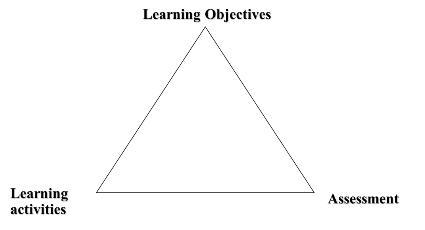2a. Learning objectives and observable behaviour
Course subject(s)
2. Constructing well-formulated learning objectives
The importance of well-formulated learning objectives
As we have seen, constructive alignment is at the heart of a solid course design:

The first step in designing a well aligned course is to formulate good learning objectives. If it is not clear what students should have learned at the end of your course, there is no way of knowing what and how to assess and which teaching and learning methods should be used.
Key conditions of good learning objectives
A good learning objective meets the following two conditions:
- It is specific with respect to the content
- It is phrased in terms of observable behaviour
Here are some examples of well formulated learning objectives from courses taught at Delft University of Technology:
- Students are able to describe the forming and transformation of particular landscapes and their current architectural and spatial appearance.
- Students are able to derive the current distribution and radiated fields of linear dipoles.
- Students are able to set up a sales and market forecast for a new product for the first years after introduction.
As we can see, these learning objectives are specific about the content, and they are phrased in terms of observable behaviour: describe, derive and set up.
The importance of phrasing a learning objective in terms of observable behaviour
Why is it so important that learning objectives are phrased in terms of observable behaviour?
To illustrate this, let’s take a learning objective that states the frequently used, non-observable notion of ‘to understand’:
Students should be able to understand Newton’s third law of motion
(When one body exerts a force on a second body, the second body simultaneously exerts a force equal in magnitude and opposite in direction to that of the first body)
If we now think about the best way to assess this, we immediately have a problem: how can we assess understanding? We cannot see whether students understand. We need them to actually do something that will demonstrate their understanding. We can for example ask them to explain Newton’s third law of motion and give an example of the application of the law. We can now rewrite the learning objective into: ‘Students should be able to explain and give an example of Newton’s third law of motion’. And now we also know what the teaching and learning activities should consist of: training in explaining and giving examples of applications of this law.
So, formulating learning objectives in terms of observable behaviour is essential in designing an aligned course. Also, it makes it very clear for students what is expected of them!
Verbs such as ‘understand’, ‘know’, ‘to be aware of’, ’appreciate’, or ‘have a feeling for’ should be avoided. When we ask ourselves what we are going to let students do in order to demonstrate whether they have obtained this objective, we usually end up with an appropriate action verb.
One way that will help you to formulate learning objectives well, is to use the following phrase:
After this course students are able to (action verb) …

Development of Teaching and Active Learning by TU Delft OpenCourseWare is licensed under a Creative Commons Attribution-NonCommercial-ShareAlike 4.0 International License.
Based on a work at https://ocw.tudelft.nl/courses/development-teaching-active-learning/.



